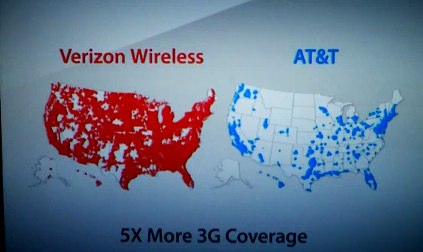Memo to AT&T: When you're in a hole, stop digging


AT&T has posted on its Web site an open statement to its customers to whine - again - about those Verizon Wireless TV commercials that paint a sad picture of the wireless 3G coverage that AT&T offers in the United States. (see image on right, video below) The statement is really sort of pathetic, an act of desperation that attempts to paint Verizon's ads as "blatantly false and misleading" even though AT&T has already acknowledged that the ads are not, in fact, false.
We already knew that AT&T considered the ads to be misleading - that was clear in the lawsuit it filed over the ads. But false? AT&T clearly said before that what Verizon is advertising in these maps is not factually incorrect. Let's repeat that once more for emphasis: what Verizon is advertising in these maps is not factually incorrect.
AT&T's beef is that the Verizon isn't comparing all data coverage, only 3G data coverage (though I would counter that with a "Why should Verizon have to make that comparison?") In its letter to customers, AT&T attempts to clarify the points by breaking out the coverage of its different data offerings. In total, the company's wireless data coverage reaches 303 million people – or 97% of the U.S. population, it said, with three different types of technology. (Here's where we start splitting hairs), Those technologies are:
- 3G, which reaches 233 million people, or 75 percent of the population
- EDGE, which reaches 301 million people or 96 percent of the population.
- GPRS, which reaches 303 million people, or 97 percent of the population
From the AT&T statement:
With both 3G and EDGE coverage, customers can access the Internet, send e-mail, surf the Web, stream music, download videos, send photos, text, talk and more. The only difference – with some data applications, 3G is faster than EDGE
So, again, the map that Verizon is showing is not wrong. AT&T is just concerned that, by not showing the areas that EDGE covers on the AT&T map, Verizon is implying that there is no service of any kind in the white-space areas of that map. Verizon, of course, isn't saying such a thing and, interestingly enough, AT&T has no beef with the language or legal disclosures in those commercials - just the colors on the maps. You see, the company thinks consumers are too dumb to know the difference between 3G and non-3G coverage. Here's the data coverage map that AT&T wants consumers to see:
AT&T has taken a public relations beating over its poor 3G data coverage in the past, largely by disgruntled iPhone users who are often frustrated that their powerful - and expensive - smartphone is handicapped by a network that cannot consistently keep up with what the iPhone can do. AT&T has had several years now to get it right - but has largely failed.
Also see: AT&T: The iPhone's anchor
Suddenly, though, there's some real competition looming around. Google and Verizon have cut a deal to bring Android phones to the stronger carrier and let's not forget the rumors of Apple shopping other carriers - including Verizon - for deals when the exclusive deal with AT&T ends, believed to be next year.
And so, AT&T has been reduced to filing lawsuits and issuing public statements to make the competition look bad when, in fact, AT&T is only trying to mask the truth: when it comes to offering a widespread 3G network, AT&T lags far behind the competition.